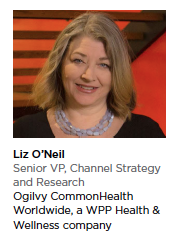 In pharmaceutical communication planning, the discovery work of digging into a category, understanding the patient journey, and thinking about how a brand can have a relationship with their customer is both exciting and challenging. The exciting part is creating a communication map to capture the patient journey and the opportunities for the brand to connect and help them overcome obstacles that deter the best outcome. The challenging part is that it is difficult to break some of the entrenched brand-centric thinking as the industry shifts to a patient-centric mindset. This shift is not a slight behavior change, but a seismic shift from historic practices.
In pharmaceutical communication planning, the discovery work of digging into a category, understanding the patient journey, and thinking about how a brand can have a relationship with their customer is both exciting and challenging. The exciting part is creating a communication map to capture the patient journey and the opportunities for the brand to connect and help them overcome obstacles that deter the best outcome. The challenging part is that it is difficult to break some of the entrenched brand-centric thinking as the industry shifts to a patient-centric mindset. This shift is not a slight behavior change, but a seismic shift from historic practices.
Addressing Patients’ Unmet Needs
Patient solutions today are quite often companions to the medication, such as an intuitive patient support program, an innovative adherence technology, or a turn-key brand savings card. Many programs are addressing pain points for the brand which are earnestly mapped as patient barriers — barriers such as perceived expense of medication, troubling side effects, or unfriendly dosing.
These barriers are true and need to be managed, but are still brand pain points.
We can and should push our insights on patient journeys to reveal a true patient-centric perspective. Patient solutions can be innovative beyond the medication.
If pharma stays status quo, it risks being the necessary evil, rather than the partner in care. For big pharma to become an indispensable part of the new healthcare ecosystem, they should diversify the focus of healthcare beyond the molecule and develop solutions that are addressing the patient’s unmet needs. Putting a patient-centric process in place will reveal pain points and opportunities for improvement to the existing system. Depending on the perspective, these can be seen as barriers for adoption of product or they can be seen as “innovation opportunities." Build a culture that wants to drive new opportunities. There is opportunity to build relationship with partners and patients and solve patient problems.
Mapping a Patient Journey
Mapping a patient journey uncovers the messiness of being ill. When building the journey, consider patients in the most human sense and try to be empathetic. There are masses of data at our fingertips. Start by digging into claims data, social listening, syndicated reports, search behavior, and articles to understand what is going on with these patients. Use this information to plot out the stages and behaviors. What content do they use, what doctors do they see, what other influencers help guide them? As the journey comes to life, it may be clear that the treatment, in many cases, is only a small part of the journey. The healthcare ecosystem is addressing this full journey and trying to connect the care. Technology giants and small start-ups are filling in this space. Can pharma expand?
Yes, there are many roadblocks when coming up with solutions, but if there is a willing client, there is always a way. Let’s for a moment imagine a world where the industry does expand. What if a pharmaceutical company was patient-centric and thought about the pain points that a patient faces? What about the family that travels over eight hours to get to a cancer center, and can’t find short-term housing during their loved one’s stay? Why is Ronald McDonald filling this gap in care? It is time to be transformative.
Patient Solutions Beyond Medication
Pharma companies have the brightest minds in science. They work with top specialists and KOLs to have clinical trials run that result in valuable data and learning. They research and understand customers, which results in valuable data and learnings. Now use the data and insights to build out a new frontier of patient solutions. The pharma culture is built to do this; experiments and sprints and hackathons are happening every day. What is needed is permission and outlets to build patient solutions beyond the medication. And being a partner in health by leveraging the insight and understanding of the patient to do more to drive innovation. What if business incubators are set up inside pharma companies? that evaluate these opportunities? Pharma has the potential to create patient solutions, and the time is now.(PV)
Ogilvy CommonHealth Worldwide — a WPP Health & Wellness company — is committed to creativity and effectiveness in healthcare communications, everywhere.
For more information, visit ogilvychww.com










